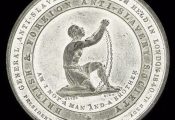Thomas Clarkson was a key campaigner for the abolition of the slave trade and gathered evidence and witnesses for the cause, particularly from sailors. This evidence was used in Parliamentary enquiries to highlight the inhumanity of the slave trade and slavery.
The watercolour by Alfred Edward Chalon shows Thomas Clarkson seated with his travelling chest by his feet. This chest contained African products, as well as restraints and punishment implements illustrating the great cruelty and loss of life resulting from the slave trade. He tried to show that African foodstuffs, dye plants and manufactured items such as fine textiles and intricately crafted weapons, could replace the trade in slaves, to the benefit of both African and European traders. A map of Africa is also depicted. Using the chest as a campaigning tool, Clarkson embarked on a nationwide tour to help mobilise a mass abolition movement that involved many people including women and the working class, a group ignored by the political elite.
The busts on the mantelpiece are of William Wilberforce and Granville Sharp, two fellow abolitionists. Wilberforce and Clarkson were great friends, despite their differing approaches to tackling the campaign for the abolition of the slave trade and slavery.
© Hull Museums
Accession reference: Hull Museums KINCM:1980.840


